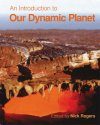Textbook
By: Nick Rogers(Editor), Stephen Blake(Contributor), Kevin Burton(Contributor), Mike Widdowson(Contributor), Ian Parkinson(Contributor), Nigel Harris(Contributor)
398 pages, 250 colour illustrations
![An Introduction to Our Dynamic Planet An Introduction to Our Dynamic Planet]()
Click to have a closer look
About this book
Contents
Customer reviews
Biography
Related titles
About this book
This is the first undergraduate textbook to fully integrate results from geophysics, geochemistry, and petrology to describe the structure, composition, and dynamic processes that operate throughout the solid Earth. It presents an Earth system science approach to studies of the Earth's interior and develops a global view of solid Earth cycles to explain geodynamic and plate tectonic processes.
An Introduction to Our Dynamic Planet initially explores the formation and evolution of the early Earth, then considers the operative forces for plate tectonic movements at the Earth's surface, and finally discusses global cycles within the deep Earth and their effect on the surface environment. Interactions between the geosphere, hydrosphere, and atmosphere, and their influence at and beneath the Earth's surface are examined in detail. An Introduction to Our Dynamic Planet thus provides a concise yet extensive coverage of the solid Earth. Written for intermediate undergraduates, it includes a wealth of features to support student learning at this level.
Contents
1. An introduction to the structure and composition of the Earth
2. The earth Earth
3. Plate tectonics
4. Processes at constructive plate boundaries
5. Processes at destructive plate boundaries
6. Processes during continental collision
7. The deep mantle and global cycles
8. The continental crust
Answers to questions
Appendices
Further reading
Glossary
Index
Customer Reviews
Biography
Nick Rogers is a Senior Lecturer in Earth Sciences at the Open University, Milton Keynes, UK. His research interests are in the field of trace element and isotope geochemistry applied to igneous petrology, the composition of the mantle, and the interaction of mantle plumes with the continental lithosphere. Dr Rogers is a Council Member of The Geological Society of London and is also their Publications Secretary.
Textbook
By: Nick Rogers(Editor), Stephen Blake(Contributor), Kevin Burton(Contributor), Mike Widdowson(Contributor), Ian Parkinson(Contributor), Nigel Harris(Contributor)
398 pages, 250 colour illustrations
"Other books on global solid Earth processes lean heavily towards geophysics or geochemistry. This new textbook is a welcome departure from that model, with chapters arranged by process or region rather than by discipline (seismology, geodynamics, petrology). It is an excellent book for undergraduate students who need to broaden their backgrounds and learn to integrate their thinking."
- Scott King, Virginia Polytechnic Institute and State University
"I welcome the Earth systems science approach adopted by the authors to deliver a book of significant quality to academia."
- The Geographical Journal
"[...] recommend[ed] [...] strongly for graduate students and geoscience teachers. Undergraduate students may use it successfully as a supplementary or advanced textbook. To read this book will also be very helpful for professionals."
- Zentralblatt für Geologie und Paläontologie



































